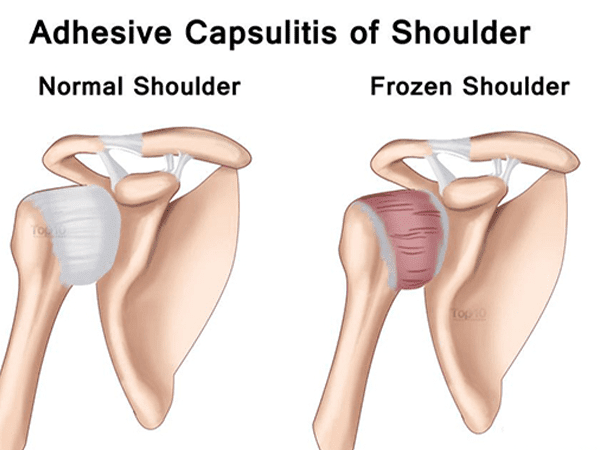Frozen shoulder, also called adhesive capsulitis, is a condition that causes pain and stiffness in the shoulder. The shoulder joint is enclosed in a capsule of connective tissue. In frozen shoulder, this capsule thickens and tightens around the shoulder joint, restricting its movement.
The exact cause of frozen shoulder is unknown, but it is thought to be a combination of factors, including:
Injury to the shoulder
Diabetes
Hypothyroidism
Heart disease
Stroke
Rheumatoid arthritis
Surgery on the shoulder
Radiation therapy to the shoulder
Frozen shoulder is most common in people between the ages of 40 and 60, and it affects women more often than men.
Symptoms of frozen shoulder typically begin slowly, then get worse over time. The most common symptoms are:
Pain in the shoulder
Stiffness in the shoulder
Difficulty moving the shoulder.
Pain at night

The symptoms of frozen shoulder are divided into three stages:
Freezing stage: This stage lasts for 3 to 6 months. The shoulder becomes stiff and is painful to move. The pain slowly increases. It may worsen at night. Inability to move the shoulder increases.
Frozen stage: This stage lasts for 4 to 12 months. Pain may lessen, but the shoulder remains stiff. This makes it more difficult to complete daily tasks and activities.
Thawing stage: This stage lasts for 6 to 12 months. Pain lessens, and ability to move the shoulder slowly improves.
In most cases, frozen shoulder resolves on its own within 1 to 3 years. However, some people may experience long-term pain and stiffness.
There is no cure for frozen shoulder, but there are treatments that can help relieve symptoms and improve range of motion. Treatment options include:
Physical therapy: Physical therapy can help to increase range of motion and reduce pain.
Stretching exercises Stretching exercises can help to improve range of motion.
Ice therapy: Ice therapy can help to reduce pain and inflammation.
Heat therapy: Heat therapy can help to relax muscles and improve range of motion.
Oral medications: Oral medications, such as nonsteroidal anti-inflammatory drugs (NSAIDs), can help to reduce pain and inflammation.
Corticosteroid injections: Corticosteroid injections can help to reduce inflammation and pain.
Surgery: Surgery is rarely needed to treat frozen shoulder. However, surgery may be an option for people who have severe pain and stiffness that does not improve with other treatments.
If you are experiencing pain and stiffness in your shoulder, it is important to see a doctor to get a diagnosis and discuss treatment options.
What are the Symptoms of Frozen Shoulder?
The most common symptom of frozen shoulder is pain. The pain is usually worse at night and when the shoulder is moved. The pain can be so severe that it makes it difficult to sleep or to do everyday activities, such as dressing, bathing, or brushing your hair.
Another common symptom of frozen shoulder is stiffness. The shoulder joint becomes stiff and difficult to move. This can make it difficult to reach for things, to put on a coat, or to raise your arm above your head.
Frozen shoulder is usually diagnosed based on your symptoms and a physical examination. Your doctor may also order an X-ray to rule out other conditions, such as arthritis or a fracture.
Who gets frozen Shoulder?
The exact cause of frozen shoulder is unknown, but it is thought to be due to a combination of factors, including:
Inflammation of the shoulder joint capsule
Reduced blood flow to the shoulder joint
Scar tissue formation
Reduced range of motion in the shoulder
Frozen shoulder typically progresses through three stages:
Freezing stage: This stage typically lasts for 3 to 9 months. During this stage, the shoulder becomes increasingly stiff and painful.
Frozen stage: This stage typically lasts for 4 to 12 months. During this stage, the shoulder is very stiff and painful. It is difficult to move the shoulder, even for simple tasks such as getting dressed or brushing your hair.
Thawing stage: This stage typically lasts for 12 to 24 months. During this stage, the shoulder gradually becomes less stiff and painful. The range of motion in the shoulder improves.
How is Frozen Shoulder Diagnosed?
If you have been diagnosed with frozen shoulder, there are several treatments that can help to improve your symptoms and range of motion. These treatments may include:
Physical therapy: Physical therapy can help to improve your range of motion and strength.
Stretching and strengthening exercises: You can do these exercises at home or with the help of a physical therapist.
Pain medication: Over-the-counter pain medication, such as ibuprofen or acetaminophen, can help to relieve pain. In some cases, your doctor may prescribe stronger pain medication.
Corticosteroid injections: Corticosteroid injections can help to reduce inflammation and pain.
Arthroscopy: Arthroscopy is a minimally invasive surgery that can be used to release adhesions in the shoulder joint.
With time and treatment, most people with frozen shoulder will experience improvement in their symptoms and range of motion. However, it can take up to 3 years for the condition to fully resolve.
